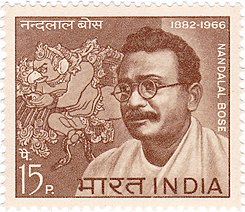Nandalal Bose | |
|---|---|
 Bose on a 1967 stamp of India | |
| Born | 3 December 1882 |
| Died | 16 April 1966 (aged 83) Santiniketan, West Bengal, India |
| Nationality | Indian |
| Known for | Painting |
| Movement | Contextual Modernism |
| Spouse | Sudhira Devi (1903) |
| Relatives | Gouri Bhanja (daughter) Jamuna Sen (daughter) Surendranath Kar (cousin) |
| Awards | Principal of Kala Bhavana, Santiniketan (1921), Padma Vibhushan (1954), Fellow of the Lalit Kala Academy (1954), Deshikottam (1952), honorary doctor of the University of Calcutta |
Nandalal Bose (3 December 1882 – 16 April 1966) was one of the pioneers of modern Indian art and a key figure of Contextual Modernism.
A pupil of Abanindranath Tagore, Bose was known for his "Indian style" of painting. He became the principal of Kala Bhavan, Santiniketan in 1921. He was influenced by the Tagore family and the murals of Ajanta; his classic works include paintings of scenes from Indian mythologies, women, and village life.
Today, many critics consider his paintings among India's most important modern paintings.[2][3][4] In 1976, the Archaeological Survey of India, Department of Culture, Govt. of India declared his works among the "nine artists" whose work, "not being antiquities", were to be henceforth considered "to be art treasures, having regard to their artistic and aesthetic value".[5]
He was given the work of illustrating the constitution of India.
- ^ C. H. Prahlada Rao (January 2014). "Nanadlal Bose". Rashtrotthana Sahitya.
- ^ "San Diego museum showcases Nandalal Bose". Rediff.com News. 25 June 2008.
- ^ Robert L. Pincus (15 March 2008). "The Art of Nandalal Bose' is first U.S. showcase for an Indian icon". Paramus Post. Archived from the original on 29 October 2013. Retrieved 23 May 2009.
- ^ Kamala Ganesh; Usha Thakkar (13 July 2005). Culture and the Making of Identity in Contemporary India. SAGE Publications. pp. 49–. ISBN 978-0-7619-3381-6.
- ^ Nine Masters "The Government Museum and Art Gallery Chandigarh, India". Archived from the original on 7 September 2015. Retrieved 28 January 2010. Government Museum and Art Gallery, Chandigarh. "Nine Masters: Rabindranath Tagore, Amrita Sher-Gil, Jamini Roy, Nandalal Bose, Raja Ravi Varma, Gaganendranath Tagore, Abanindranath Tagore, Sailoz Mookherjea, and Nicholas Roerich."